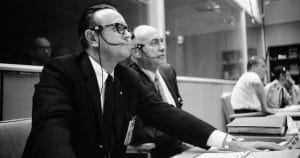In 1944, with a newly minted degree in Aeronautical Engineering from Virginia Tech, Kraft was hired by the National Advisory Committee for Aeronautics, working on aeronautical research for 14 years until he was asked to take on a new assignment. That year, the organization was renamed to the National Aeronautics and Space Administration, and Kraft was assigned to the Space Task Group. Its mission: to manage the agency’s new push to fly humans in space. Kraft was assigned to the flight operations division, and his new boss gave him this directive: “Chris, you come up with a basic mission plan,” Chuck Mathews said. “You know, the bottom-line stuff on how we fly a man from a launch pad into space and back again. It would be a good idea if you kept him alive.” Kraft realized that during a launch, so many things would be going on that a large team was needed to ensure the procedures he wrote were all done correctly, and in the right order.

Kraft defined and developed an operations facility, and defined what it needed: a communications network, spacecraft tracking systems, telemetry downloads, flight plans, timelines, constraints and flight rules, standard and contingency procedures, plans and techniques to locate and recover the astronauts and spacecraft after splashdown in the ocean. He’d need highly trained engineers to develop command and control protocols for running through those timelines and flight plans, but be ready to react to any problems in real time. Kraft established a control room at the Cape Canaveral Missile Test Annex in Florida, where the first Mercury missions were launched. When the Mercury program was done, with Gemini to follow, Kraft realized that the Mercury Control Center was insufficient. Further, the Manned Spaceflight Center, where astronauts trained and lived, was in Houston, Texas.
That gave him the opportunity for a complete do-over. In 1961, with lessons learned from early missions, Kraft and three other flight controllers mapped out what would be needed in a command center for the more complex missions of Gemini and Apollo. Construction was started in 1963, and was first used for Gemini 3 in March, 1965. It was called “Mission Control” — but it’s perhaps better known worldwide by its radio callsign: “Houston”. Kraft “personally invented the mission planning and control processes required for crewed space missions,” NASA said in a press release, “in areas as diverse as go/no-go decisions, space-to-ground communications, space tracking, real-time problem solving, and crew recovery.” Kraft didn’t just create Mission Control, he wrote its procedures and rules for operations. As the Apollo program progressed, Kraft was made NASA’s Director of Flight Operations. In 1972, he was made Director of the Manned Space Center, which was renamed Lyndon B. Johnson Space Center in 1973. He retired from NASA in 1983. In 2011, Mission Control was renamed to the Christopher C. Kraft Jr. Mission Control Center in his honor. He died July 22, at 95.
Related in my Blog: One Small Step for [a] Man and The Giant Leap for Mankind.
